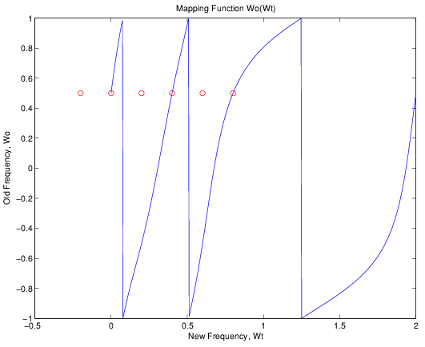allpasslp2mbc
Allpass filter for lowpass to complex M-band transformation
Syntax
[AllpassNum,AllpassDen] = allpasslp2mbc(Wo,Wt)
Description
[AllpassNum,AllpassDen] = allpasslp2mbc(Wo,Wt) returns
the numerator, AllpassNum, and the denominator, AllpassDen,
of the Mth-order allpass mapping filter for performing
a real lowpass to complex multipassband frequency transformation.
Parameter M is the number of times an original
feature is replicated in the target filter. This transformation effectively
places one feature of an original filter, located at frequency Wo,
at the required target frequency locations, Wt1,...,WtM.
Relative positions of other features of an original filter do not change in the target filter. This means that it is possible to select two features of an original filter, F1 and F2, with F1 preceding F2. Feature F1 will still precede F2 after the transformation. However, the distance between F1 and F2 will not be the same before and after the transformation.
Choice of the feature subject to this transformation is not restricted to the cutoff frequency of an original lowpass filter. In general it is possible to select any feature; e.g., the stopband edge, the DC, the deep minimum in the stopband, or other ones.
This transformation can also be used for transforming other types of filters; e.g., notch filters or resonators can be easily replicated at a number of required frequency locations without the need to design them again. A good application would be an adaptive tone cancellation circuit reacting to the changing number and location of tones.
Examples
Design the allpass filter changing the real lowpass filter with
the cutoff frequency of Wo=0.5 into
a complex multiband filter with band edges of Wt=[-3+1:2:9]/10 precisely
defined:
Wo = 0.5; Wt = [-3+1:2:9]/10; [AllpassNum, AllpassDen] = allpasslp2mbc(Wo, Wt);
Calculate the frequency response of the mapping filter in the full range:
[h, f] = freqz(AllpassNum, AllpassDen, 'whole');
Plot the phase response normalized to π, which is in effect
the mapping function Wo(Wt).
Please note that the transformation works in the same way for both
positive and negative frequencies:
plot(f/pi, angle(h)/pi, Wt, Wo, 'ro');
title('Mapping Function Wo(Wt)');
xlabel('New Frequency, Wt'); ylabel('Old Frequency, Wo');In this example, the resulting mapping function converts real filters to multiband complex filters.

Arguments
| Variable | Description |
|---|---|
Wo | Frequency value to be transformed from the prototype filter. It should be normalized to be between 0 and 1, with 1 corresponding to half the sample rate. |
Wt | Desired frequency locations in the transformed target filter. They should be normalized to be between -1 and 1, with 1 corresponding to half the sample rate. |
AllpassNum | Numerator of the mapping filter |
AllpassDen | Denominator of the mapping filter |
Version History
Introduced in R2011a
